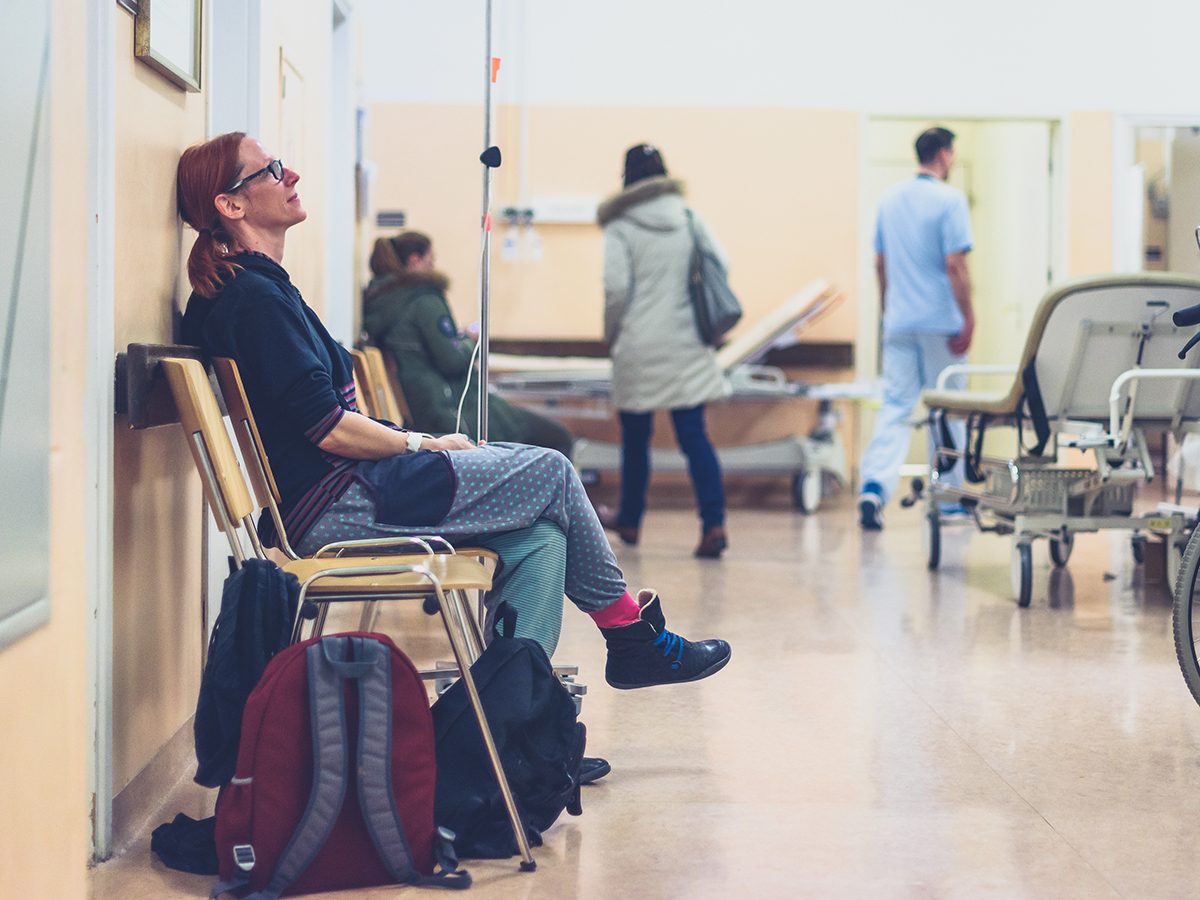
The rise of “cyberchondria”
It always began the same way—an ache, say, or stomach pains while strolling across campus to her dorm. Soon enough, Emma Murray (name has been changed to protect privacy), a first-year psychology student at McGill University in Montreal, would open her laptop, type her symptom into Google and read and read and read. She’d switch between medical websites—Mayo Clinic, MedlinePlus, WebMD—and compare warning signs until a twinge on the side of her face signalled a stroke. She’d stumble across a forum and discover her fatigue was the onset of lupus or, no, multiple sclerosis. God, did she have Addison’s disease, a rare disorder of the adrenal glands? When her dread became unbearable—when, after clicking through endless symptom checklists, every sensation seemed a death sentence—she’d stop. She was okay, she would tell herself. She’d shut her laptop and curl up in bed, pictures of friends and family on the walls of her room. She was okay. But she couldn’t sleep. She was never sure.
Many aren’t. According to Statistics Canada, nearly 65 per cent of Canadians use the Internet to search for health information. Some studies suggest, however, that the onslaught of advice may put one in 20 of those Googlers at risk of becoming “cyberchondriacs”—people obsessed with the idea of being stricken by diseases they find online. While the Internet can be a useful misconception-clearing tool, the nature of search results—where the highest-ranked sites are a measure of attention paid to those particular pages—can also make it easy to find the most dire, and least probable, explanation for your symptoms. Cyberchondria is not an official medical condition, yet a growing body of research now files it under the same heading as hypochondria—the constant and excessive fear of serious illness. Indeed, according to the symptoms in the newly released fifth edition of the American Psychiatric Association’s DSM (Diagnostic and Statistical Manual of Mental Disorders), cyberchondria is an illness anxiety disorder. No one’s sure what causes it. Hereditary disposition and environment seem to be factors. In most cases, it’s triggered by a serious illness or a death in the family.
Murray’s anxieties began at 13, right after her mother died. Her teenage years were a blur of grief, stress and dramatic, inexplicable symptoms: pounding headaches, severe pains. Her doctors told her it was all in her head, dismissing her constant requests for blood tests until she was eventually diagnosed with an ovarian cyst and hospitalized. That only made things worse. She stopped being able to tell real pain from imagined, and started to panic. “When you’re anxious,” she says, “your body can make you feel a lot of things that aren’t necessarily happening.” But on the Internet, her fears seemed well-founded. There was always a website she could turn to that would confirm something was wrong.
Worrywarts have been diagnosing themselves for hundreds of years, basing their false convictions of illness on circulating medical theories. In his 1621 book The Anatomy of Melancholy, which collected the period’s prominent philosophical and scientific ideas, English scholar Robert Burton described many of the hypochondria symptoms (“heat in the bowels, wind and grumbling in the guts”) that gripped Europeans at the time. “Some are afraid that they shall have every fearful disease they see others have, hear of, or read,” he wrote, “and dare not therefore hear or read of any such subject.” The difference today is that our phobias can feed on a vast amount of data, much of it unvetted, and all of it just a keystroke away. Patients once limited to scouring medical textbooks now have clinical trials, specialized forums, Facebook groups and Twitter feeds. Another difference? Online pharmacies mean patients can opt to take matters—and powerful medication—into their own hands.
Canadians don’t need to be cyberchondriacs to put themselves in danger; they just need to trust the wrong information. While the Internet has been an empowering force, health-care professionals wonder if the countless hours patients spend online may be doing more harm than good.

Separating fact from fiction (and outright fraud)
Ross Upshur couldn’t believe what he was hearing. “Twelve thousand dollars? To someone in Alaska?” he asked. The sheepish 76-year-old man in front of him had been Upshur’s patient for more than 10 years. He suffered from pulmonary fibrosis, an illness where one’s lungs stiffen up over time, making it harder and harder to breathe. The condition nearly always leads to death. There’s no known cure. The only treatment Upshur could offer was symptomatic: if the patient was very short of breath, he’d be given oxygen; if he had a lung infection, steroids. But the man had already lived with the disease for a decade, knowing it was slowly draining his life away. He was desperate for a miracle. And these pills promised him that. He’d found them online, and they could be his for $12,000. It didn’t matter that he was on a fixed income and the cost would blow through everything he had.
Upshur is a physician and the Canada Research Chair in primary-care research. But when he first started his career more than 30 years ago, he worked as a rural family physician in the town of Chesley, Ont. Farmers would come to see him and explain their symptoms in their own words. He’d examine them, run tests and offer a diagnosis. Now, he says, when well-educated patients come in, he has to “undiagnose” them before he can get to what’s actually happening. His patients complain they have angina or gallbladder disease or liver disease, based on symptoms provided by a search engine. “People will take what they’re experiencing and punch it into Google. The search will come out with a long list of possibilities, and they’ll match it to the one they like best,” he says.
Upshur is far from anti-Google. In fact, for years he had encouraged his pulmonary fibrosis patient to conduct his own research into his condition, print out any relevant materials and bring them in to discuss. The intention was to make his patient feel invested in his own care. But the democratization of health-care information has had a dangerous downside: self-declared experts who, like the quackery potion-and-powder scams popular in the 18th century, prey on sufferers frantic for help. Osteoarthritis, for example, is a painful joint disease and a leading cause of chronic disability. Prescription drugs offer relief; joint-replacement surgery can also help. Type “osteoarthritis cure” in Google, however, and you’ll get over 59,000 hits. To the untrained eye, it can be tough to tell the difference between results that are scientific, biased or fake, unless you track the info back to its original study. Even then, without knowing if independent researchers conducted the study, it’s easy to get duped. According to research cited by Microsoft in a 2008 study, the majority of searchers never bother to check a source’s validity; most worrisome, a recent poll found that 67 per cent of Canadians trust the advice they get online. Luckily, Upshur’s pulmonary fibrosis patient came to him before he dished out a small fortune on a miracle cure. “There’s not a shred of evidence this will make a difference,” Upshur told the man. “Do you honestly think I would withhold something from you that would benefit you?”
Don’t miss these tips on how to communicate effectively with your doctor.

The dangers of self-medication
A self-described information junkie, Upshur is glued to his iPad. He uses an application called QxMD that scans the tables of contents of medical journals so he can determine what studies he needs to read. He says he uses Google about 40 times a day to access review articles. And he’s not alone: a 2011 study found that 46 per cent of U.S. physicians go online for medical information. “If we know where trusted and credible sources are, we can direct our patients to that,” explains Upshur. And sometimes he gets schooled by patients—not even the best doctors can keep up with every new health study. “I’ve had patients bring me studies that I haven’t read, which actually can be germane to their care,” he says.
Indeed, among American patients who reported bringing their hypotheses to doctors, 41 per cent claimed they were vindicated. That still leaves a majority harbouring incorrect theories, and some may be so secure in their self-diagnosis they’ll skip seeing a doctor altogether. Sean Cummings, a physician writing for the United Kingdom’s Daily Mail, describes how, when one of his patients experienced stomach pain and weight loss, she attributed it to the diet she’d recently started. When she began to feel pain and itching while peeing, she went online and concluded it was a urinary tract infection. Not so—when she finally went to see him six months later, Cummings found she had advanced cervical cancer.
Upshur fears the increasing popularity of self-medication may be having fatal results. The Center for Medicine in the Public Interest, an American non-profit patient-advocacy group, estimates the global counterfeit-drug market is worth US$75 billion a year and kills about 700,000 people annually. Given the speed at which they set up shop and disappear, Internet pharmacies are difficult to monitor and regulate. Many have become skilled at imitating the layout of licensed sites, and some even ask patients to input a prescription number. The World Health Organization says more than half the drugs bought from sites that hide their physical addresses are counterfeit, meaning falsely labelled or containing incorrect dosages or insufficient ingredients. One U.K. study reported that a quarter of women searching for medical advice online purchase black-market drugs, and a tenth of those people become ill because of it. Health Canada doesn’t log statistics for numbers of patients who self-medicate, but in December 2007 the country was given a grisly reminder of the risks.
Two days after Christmas, a neighbour found 58-year-old Marcia Bergeron dead in her house on Quadra Island in British Columbia. Hundreds of pills in unmarked bags were scattered around. They were filled with anti-anxiety medication and a powerful sleep aid called zolpidem, unavailable in Canada. Her toxicology report found traces of over-the-counter pain relievers and muscle relaxants, as well as prescription antidepressants. Her liver, moreover, had been poisoned with high levels of materials used as “filler” in the pills: aluminum, phosphorus, titanium, tin, strontium and arsenic. Earlier that month, Bergeron had reported to friends and family that she was experiencing severe nausea and blurry vision, and her thick red hair had started to fall out. Investigators concluded her symptoms were caused by counterfeit drugs she had purchased from a website claiming to be a Canadian pharmacy. It wasn’t. The drugs were produced in Southeast Asia and shipped from somewhere in eastern Europe. The sicker Bergeron felt, the more pills she ingested. According to the coroner, she was the first recorded Canadian to be killed by the Internet.
Find out which prescription drugs and supplements you should never mix.

Fact-checking Wikipedia
James Heilman is on a mission to fix Wikipedia. He believes skewed and half-baked information circulating online menaces our health-care system and the well-being of its patients. He doesn’t want people to get sick. Nor does he want people to make themselves sick obsessing over possible symptoms. So he works slowly to correct Wikipedia’s medical articles, sentence by sentence, study by study, from anywhere—at home; in the emergency room where he works as a doctor; or at the airport waiting for a flight. Heilman started years ago when, during a slow night in the ER, he came across an error-riddled obesity article. Realizing he could edit the entry, he dived in, making hundreds of changes, from updating citations to changing unclear language and ambiguous vernacular. He went from there. Wikipedia’s open-source philosophy means others can undo his work. But he’s not alone: 655 Wikipedians monitor the obesity article for changes. Those volunteers aren’t all doctors, but many share Heilman’s ambition. “As health-care providers, we have a responsibility to make sure what our colleagues, patients and students read is accurate,” he says.
Wikipedia is the world’s single most-used online source for health queries, often appearing in the top five results in any Google search. The site’s medical content sees an estimated 15 million page views a month in Canada alone. Wikipedia has become a solid starting point to learn about ailments and disorders because the entries—some of which are written by knowledgeable patients living with the conditions—are assayed by a team of three dozen doctors volunteering to do what they can to regulate the constant surge of information coming from 80,000 hyper-dedicated active users and new medical research being published every day. It’s slow work. Since 2008, Heilman has edited more than 10,000 of those medical articles to varying degrees. But it takes him nearly two months, between work and other research, to bring one article up to snuff. He estimates he’ll be revising his slate of 80 topics for the next six to 10 years.
Compare that to WebMD, an advertiser-funded health-information website that the New York Times has called a “hypochondria time suck.” WebMD is loaded with articles on everything from weight-loss tips to symptom checklists, but its well-documented and lucrative ties to Big Pharma have caused concern among medical professionals who complain that the site—which attracts an estimated 125 million unique users a month from around the world—tends to promote hysteria and drug-peddling. In his 2010 investigation into the company, U.S. Republican senator Chuck Grassley pressed WebMD to explain why it was offering a depression-screening test paid for by drug company Eli Lilly that pointed users toward Lilly’s antidepressant Cymbalta.
Heilman—who has often sparred with pharmaceutical companies that are trying to change Wikipedia’s content to favour their products—says sites such as WebMD have been instrumental in helping drug companies establish some conditions as diseases. “Erectile dysfunction was more or less unheard of 20 years ago, before the advent of Viagra,” adds Heilman. But in order to promote Viagra, he explains, you need to promote a disease associated with it. “Call it erectile dysfunction, and you can get approval from the Food and Drug Administration,” he says. WebMD’s recommendations for erectile dysfunction? Minor lifestyle changes: lose weight, quit smoking and cut down on alcohol. But it also insists men may need further treatment including—surprise—medication. And to the left of the article? A banner ad for Cialis.
Heilman is a full-fledged advocate of online health-care information sharing, and spends dozens of hours a week reading up on new cases to help him hone his judgment calls in the ER. He admits online forums can be destructive—U.S. drug companies have been suspected of covertly setting up health sites and hiring “independent” health bloggers to praise their own meds—and that even harmless-looking sites such as Yahoo! Answers offer alarmist information. “The most important thing is to be skeptical and to speak to your doctor before you act on anything you read on a medical website—no matter how reliable it seems,” he says. Still, Heilman is happy the days of doctors as medical gatekeepers are over. “I think it’s excellent that patients are becoming involved in their care,” he says. In the meantime, he’s going to do everything he can to ensure that when they start looking for answers, accurate information is what they find.
How well do you know your health lingo? Test your knowledge with our medical trivia quiz.

Overcoming cyberchondria
After about a year of chasing phantom health scares, Emma Murray’s intellect won out. As facts bested her emotions, she stopped looking up her symptoms. Internet searches can’t tell you what runs in your family or understand your recent stresses. All they can do is process a string of terms. She knows that now. A mix of therapy and a strong support network helped her move forward. Today, Murray is in her third year of medical school at Hamilton’s McMaster University and plans to be a pediatrician. When she was first accepted, friends and family were concerned. “You’re going to be incapacitated by your anxiety,” they told her. “All medical students become hypochondriacs.” Instead, her health concerns have all but evaporated. She’s now the voice of reason for her peers. “They’ll say, ‘Oh, my God, I think I have lymphoma!’ And I’ll say, ‘Okay, you obviously don’t.'”
She argues that the question of whether Internet searches are bad for health care depends on too many variables. “If patients are willing to do some legwork, most physicians would say, ‘Great, let’s talk about it,'” she says. “Doctors have a limited amount of time to devote to a case, so if people can advocate for themselves, it has the potential to lead to better treatment.”
On her clinical rotations, Murray can always spot the frantic, information-seeking cyberchondriacs fidgeting in the waiting room. “They’re common,” she says, adding that her experiences give her an empathy her own doctors lacked. When a patient, traumatized from a prolonged search session, comes to her for answers to unfamiliar sensations, she assures them that what they’re feeling is normal, that everything is okay and that a cluster of symptoms does not add up to a terminal illness. “I tell them what’s a reasonable concern and what’s not,” she says. “I’d rather they hear it from me than from the Internet.”
Next, brush up on the latest news from the world of medicine.